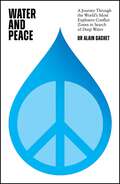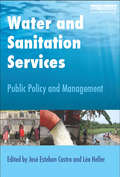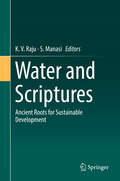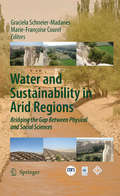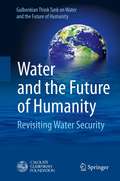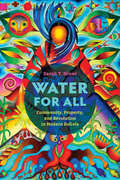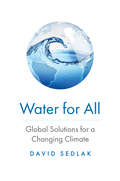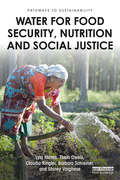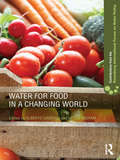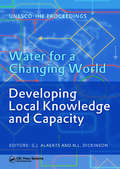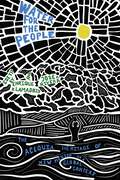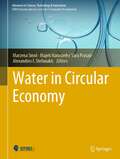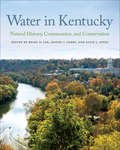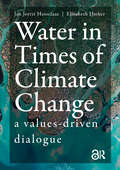- Table View
- List View
Water and Peace: A journey through the world's most explosive conflict zones in search of deep water
by Dr Alain GachetIn countries where scarce surface water causes disease and conflict, an abundance of water can bring peace.With the growing impact of climate change, an estimated one third of the world's population lacks fresh water. By 2050 it could well be over half, some five billion people.Alain Gachet, known as the "Wizard of H2O", explores and unravels the interrelated humanitarian, environmental, scientific and geo-political concerns generated by water scarcity. An archaeological explorer and mining engineer, Gachet has developed a technology (using Nasa satellite imagery) to identify massive aquifers beneath the earth's surface using a mathematical algorithm that could completely change our future.As well as exploring our current environmental crisis (and offering some solutions), Gachet gives an account of his extraordinary adventures as a mining engineer both before and since he became an expert in deep groundwater - in Congo; in Libya, where he has an audience with Colonel Gaddafi; in Darfur, where he works alongside refugee agencies to provide water to vast camps, often at risk to his life; in Iraq and in Kurdistan, where he encounters both the Peshmerga and the Yazidi people; and in the Turkana region of Kenya, where his discoveries of vast underground reservoirs have been transformative to the lives of the people in an area plagued by drought and disputes over livestock for generations.Gachet discusses the critical issues of climate change and desertification, melting glaciers and rising sea levels, but this is also a book about the people he meets in some of the world's most challenging zones of conflict and deprivation. Ultimately this is a book of hope as we explore some of the solutions for the future."If the quest to find high-quality water for millions has a superstar, that person is Alain Gachet. Living a truly adventurous life in a scientific field where underground water is hidden and elusive, he has advanced the science and, at the same time, uniquely served society. This is an exciting story of risk, daring, hydrophilanthropy, and reflection on one of the most important challenges facing humankind." DAVID K. KREAMER, President, International Association of Hydrogeologists
Water and Peace: A journey through the world's most explosive conflict zones in search of deep water
by Dr Alain GachetIn countries where scarce surface water causes disease and conflict, an abundance of water can bring peace.With the growing impact of climate change, an estimated one third of the world's population lacks fresh water. By 2050 it could well be over half, some five billion people.Alain Gachet, known as the "Wizard of H2O", explores and unravels the interrelated humanitarian, environmental, scientific and geo-political concerns generated by water scarcity. An archaeological explorer and mining engineer, Gachet has developed a technology (using Nasa satellite imagery) to identify massive aquifers beneath the earth's surface using a mathematical algorithm that could completely change our future.As well as exploring our current environmental crisis (and offering some solutions), Gachet gives an account of his extraordinary adventures as a mining engineer both before and since he became an expert in deep groundwater - in Congo; in Libya, where he has an audience with Colonel Gaddafi; in Darfur, where he works alongside refugee agencies to provide water to vast camps, often at risk to his life; in Iraq and in Kurdistan, where he encounters both the Peshmerga and the Yazidi people; and in the Turkana region of Kenya, where his discoveries of vast underground reservoirs have been transformative to the lives of the people in an area plagued by drought and disputes over livestock for generations.Gachet discusses the critical issues of climate change and desertification, melting glaciers and rising sea levels, but this is also a book about the people he meets in some of the world's most challenging zones of conflict and deprivation. Ultimately this is a book of hope as we explore some of the solutions for the future."If the quest to find high-quality water for millions has a superstar, that person is Alain Gachet. Living a truly adventurous life in a scientific field where underground water is hidden and elusive, he has advanced the science and, at the same time, uniquely served society. This is an exciting story of risk, daring, hydrophilanthropy, and reflection on one of the most important challenges facing humankind." DAVID K. KREAMER, President, International Association of Hydrogeologists
Water and Power: Environmental Governance And Strategies For Sustainability In The Lower Mekong Basin (Advances In Global Change Research #64)
by Peter A. Coclanis Mart A. StewartThis book brings together a talented international group of scholars, policy practitioners, and NGO professionals that explores a range of issues relating to environmental, developmental, and governing challenges on the Mekong, one of the world’s greatest rivers and, alas, one of the most endangered. <p><p> The book is divided into three sections devoted in turn to historical perspectives on the Lower Mekong Basin. Issues relate to livelihood strategies, environmental threats, and adaptation strategies; and various aspects of river governance, with individual authors treating questions of governance at different levels of refraction and in different registers. The result is a fresh and innovative collection of essays, which, taken together, provide much-needed new perspectives on some of the most important and seemingly intractable environmental and development issues in contemporary Asia.
Water and Sanitation Services: Public Policy and Management
by Jos LSubstantially reducing the number of human beings who lack access to clean water and safe sanitation is one of the key Millennium Development Goals. This book argues and demonstrates that this can only be achieved by a better integration of the technical and social science approaches in the search for improved organization and delivery of these essential services. It presents a historical analysis of the development of water and sanitation services in both developed and developing countries, which provides valuable lessons for overcoming the obstacles facing the universalization of these services. Among the key lessons emerging from the historical analysis are the organizational and institutional diversity characterizing the development of water and sanitation internationally, and the central role played by the public sector, particularly local authorities, in such development. It also explores the historical role played by cooperatives and other non-profit institutions in reaching rural and peri-urban areas, as well as the emergence of new forms of organization and provision, particularly in poor countries, where aid and development agencies have been promoting the self-organization of water systems by local communities. The book provides a critical exploration of these different institutional options, including the interaction between the public and private sectors, and the irreplaceable role of public funding as a condition for success. The book is divided into two parts: the first reviews theoretical and conceptual issues such as the political economy of water services, financing, the interfaces between water and sanitation services and public health, and the systemic conditions that influence the provision of these services, including the diversity of organizational and institutional options characterizing the governance and management of water and sanitation services. The second section presents a number of country or regional case studies, each one chosen to highlight a particular problem, approach or strategy. These case studies are drawn from Africa, the Americas, Asia and Europe, covering a wide range of socio-economic and political contexts. The book will be of great interest to advanced students, researchers, professionals and NGOs in many disciplines, including public policy and planning, environmental sciences, environmental sociology, history of technology, civil and environmental engineering, public health and development studies.
Water and Scriptures
by K. V. Raju S. ManasiThis collection of papers aims to draw lessons and apply indigenous knowledge, wisdom and cultural traditions to suit policy contexts describing the (a) role of individuals (b) communities, and (c) the state to ensure effectively manage water resources. Readers will discover ways in which water was conceptualized, conserved and managed. Contributions will also shed light on the historical, functional and futuristic perspectives of water resources management, and readers will be able to draw lessons and evolve policy guidelines. There are some studies related to scriptures across religions and their perceptions regarding ecological conservation. However, religious studies and their socio-economic and environmental relevance to society, more specifically to the current policy contexts, are limited. This book attempts to bridge this gap, in terms of learning lessons from the past to effectively address the challenges of the present and future. The book will be useful for historians and research scholars studying the place of water in different cultures, water pricing and water shÅ as well as ecologists and environmental scientists.
Water and Sustainability in Arid Regions
by Graciela Schneier-Madanes Marie-Francoise CourelInternational voices fill the pages of Water and Sustainability in Arid Regions, forming an original scientific exploration of current water research and management issues. In arid regions, agriculture that is ill-adapted to the environment, accelerated urbanization, poverty, and increasing pollution challenge access to and uses of water. Understanding these issues requires incorporating findings from both the physical and social sciences at different temporal and spatial scales. The chapters in this book were written by hydrologists, remote sensing specialists, ecologists, historians, economists, political scientists, architects, archaeologists, and other experts who live in and study arid lands. The authors present updates, overviews, and analyses of water challenges these areas have faced and are striving to address, from salinization in the fabled Taklimakan Desert in China to land degradation in the northern Mediterranean to groundwater over-exploitation in the southwestern United States. The book also examines desertification, remote sensing, qanat systems, architecture, arsenic contamination, and other case studies from Iran, the Maghreb region, Argentina and Chile, and Mexico. From this conceptual mosaic of comparative perspectives and research methods emerges a strong assumption: an interdisciplinary approach that combines physical and social sciences is the first step toward globally and comprehensively addressing water and sustainability."This book is a valuable and welcome contribution to the discussion of water and sustainable development. Through the collection of chapters, the book clearly illustrates the contemporary diversity of approaches to water scarcity and presents pertinent and new research findings that readers generally do not find compiled together. The result is a highly relevant, accessible, and timely resource that is unique in its international and interdisciplinary content. This is a must-read for anyone working on environmental and sustainability issues in arid lands."André Mariotti, University Pierre et Marie Curie, and INSU - CNRS (National Institute for Earth Sciences and Astronomy-National Center for Scientific Research/Centre National de la Recherche Scientifique), France "Anyone who reads this book will find himself or herself contemplating the need to rethink how we approach the issue of water and sustainability in arid lands. Drawing on the expertise of both physical and social scientists, the chapters taken as a whole present global, historic, and current perspectives on water scarcity in a multi-layered way that rarely has been done before." Miguel Solanes, Madrid Water Institute, Spain
Water and Wastewater Management: Global Problems and Measures (Water and Wastewater Management)
by Müfit Bahadir Andreas HaarstrickThis volume addresses the situation of water and wastewater management from a global angle, underpinned by selected case studies. Without doubt, water and wastewater management are among the greatest challenges of our century, and there is also no doubt that the challenges posed by climate change will become even greater. However, most efforts, especially in developing countries but also in the so-called developed countries, have been less than optimal or not optimal at all. In particular, there are still too many people who have to live without clean water and decent sanitation. Today, 2.2 billion people lack access to safely managed drinking water and wastewater, and 4.2 billion people lack safely managed sanitation services. The question, why this is so and why in many cases in developing countries, is discussed in this book among other urgent water and wastewater management issues.The publication of this book is the start of a book series that in more detail critically reviews, discusses, and analyzes the water and wastewater situation and management in different regions and countries worldwide.
Water and Wastewater: Assessment, Treatment and Management Using New Technologies
by Ajay S. Kalamdhad Izharul Haq Ankit Pratim GoswamiThis book introduces many new concepts and tactics for monitoring and assessing aspects that contribute to environmental degradation. This book will also cover wastewater treatment, groundwater, and the use of GIS tools in waste management. Bioremediation methodologies and construction and demolition wastes will receive special attention. This book covers an assortment of waste utilisation methods, such as brick production and use in wastewater treatment units. This book is meant to be of significant use to students and researchers, industrialists and academicians working in the field of environmental engineering and sciences. This can also help many colleges and institutes throughout the world who have built new prospectuses and provide specialised courses on environmental and sustainable development. Lastly, this book will be useful to all policymakers, whether in government or commercial enterprises, for the correct planning and implementation of waste management programmes.
Water and the Future of Humanity
by Springer International PublishingThis unique, engaging, and highly authoritative volume enlightens readers on changes needed in the way society accesses, provides, and uses water. It further shines a light on changes needed in the way we use food, energy, and other goods and services in relation to water, and offers projections and recommendations, up to 2050, that apply to water access challenges facing the poor and the common misuse of water in industry, agriculture, and municipalities. Written by an unparalleled slate of experts convened by the Calouste Gulbenkian Foundation, the book takes on one of the most critical issues on the planet today. In a frank yet optimistic assessment of major developmental challenges, but also opportunities, facing future generations, the author elucidates linkages between water and a range of other drivers from various disciplinary and stakeholder perspectives. Ultimately portraying the belief that Humanity can harness its visionary abilities, technologies, and economic resources for increased wellbeing and sound stewardship of resources, the book presents an optimistic statement stressing actions scientists, policy makers, and consumers can and must take to meet the water management challenges of a warming planet anticipating nine billion inhabitants by 2050. Gulbenkian Think Tank on Water and the Future of Humanity: Benedito Braga, Pres. World Water Council & Prof. of Civil Engineering, Univ. of São Paulo, Brazil; Colin Chatres, Director General of the International Water Management Institute, Sri Lanka; William J. Cosgrove, Pres. of Ecoconsult Inc. & Senior Adviser for the UN World Water Development Report, Canada; Luis Veiga da Cunha, Prof. Environmental Science and Engineering, Universidade Nova de Lisboa, Portugal; Peter Gleick, Pres. of the Pacific Institute, USA; Pavel Kabat, Director, International Institute for Applied Systems Analysis, Austria; and Prof. & Chair, Earth Systems Science, Wageningen University, The Netherlands; Mohamed Ait Kadi, President of the General Council of Agricultural Development, Morocco; Daniel P. Loucks, Prof. of Civil Engineering, Cornell Univ. USA; Jan Lundqvist, Senior Scientific Advisor, Stockholm International Water Institute, Sweden; Sunita Narain, Director, Center for Science & Environment, New Delhi, India; Jun Xia, Pres. , International Water Resources Association, Chair Prof. & Dean, The Research Institute for Water Security (RIWS), Wuhan University, China.
Water and the Rainforest in Malaysian Borneo: Hydrological Research at the Danum Valley Field Studies Center (Ecological Studies #242)
by Ian DouglasThis volume synthesizes and analyzes thirty years of hydrological research in the Danum Valley Conservation Area, a lowland dipterocarp rainforest in Sabah, Malaysia. Ian Douglas explores the role of water in the rainforest ecosystem, setting out the ecological, climatological and geological context of present-day hydrological processes, soil erosion and stream sedimentation. He emphasizes the role of extreme events and natural disturbances in sediment supplies and the evolution of drainage pathways and explains the pathways of rainfall and stream sediment. Douglas then explores the impacts caused by logging, the extreme pulses of sedimentation and the effects of log removal and logging road construction, examining the effects of major storms in the 20 years after tree harvesting. Methods of minimizing logging damage to soils and streams are discussed and the effects on flora and fauns are considered.
Water and the West: The Colorado River Compact and the Politics of Water in the American West
by Norris HundleyBack in print for the first time in over ten years, this classic account of the numerous struggles--national, state, and local--that have occurred over western American water rights since the late 1800s is thoroughly expanded and updated to trace the continuing battles raging over the West's most valuable, and contentious, resource.
Water for All: Community, Property, and Revolution in Modern Bolivia
by Sarah T. HinesWater for All chronicles how Bolivians democratized water access, focusing on the Cochabamba region, which is known for acute water scarcity and explosive water protests. Sarah T. Hines examines conflict and compromises over water from the 1870s to the 2010s, showing how communities of water users increased supply and extended distribution through collective labor and social struggle. Analyzing a wide variety of sources, from agrarian reform case records to oral history interviews, Hines investigates how water dispossession in the late nineteenth century and reclaimed water access in the twentieth and twenty-first centuries prompted, shaped, and strengthened popular and indigenous social movements. The struggle for democratic control over water culminated in the successful 2000 Water War, a decisive turning point for Bolivian politics. This story offers lessons for contemporary resource management and grassroots movements about how humans can build equitable, democratic, and sustainable resource systems in the Andes, Latin America, and beyond.
Water for All: Global Solutions for a Changing Climate
by David SedlakA fresh look at the world&’s water crises, and the existing and emerging solutions that can be used to solve them It is not your imagination: water crises are more frequent. Our twentieth-century systems for providing the water that grows food, sustains cities, and supports healthy ecosystems are failing to meet the demands of growing population and the challenges brought on by climate change. But the grim news reports—of empty reservoirs, withering crops, failing ecosystems—need not be cause for despair, argues award-winning author David Sedlak. Communities on the front lines of previous water crises have pioneered approaches that are ready to be applied elsewhere. Some have resolved shortages by enhancing water-use efficiency, and others have used moments of crisis to resolve historic disagreements over water rights. Still others have employed treatment technologies that unlock vast quantities of untapped water resources. Sedlak identifies the challenges that society faces, including ineffective policies and outdated infrastructure, and the myriad of tools at our disposal—from emerging technologies in desalination to innovations for recycling wastewater and capturing more of the water that falls on fields and cities. He offers an informed and hopeful approach for rethinking our assumptions about the way that water is managed. With this knowledge we can create a future with clean, abundant, and affordable water for all.
Water for Food Security, Nutrition and Social Justice (Pathways to Sustainability)
by Claudia Ringler Barbara Schreiner Lyla Mehta Theib Oweis Shiney VargheseThis book is the first comprehensive effort to bring together Water, Food Security and Nutrition (FSN) in a way that goes beyond the traditional focus on irrigated agriculture. Apart from looking at the role of water and sanitation for human well-being, it proposes alternative and more locally appropriate ways to address complex water management and governance challenges from the local to global levels against a backdrop of growing uncertainties. The authors challenge mainstream supply-oriented and neo-Malthusian visions that argue for the need to increase the land area under irrigation in order to feed the world’s growing population. Instead, they argue for a reframing of the debate concerning production processes, waste, food consumption and dietary patterns whilst proposing alternative strategies to improve water and land productivity, putting the interests of marginalized and disenfranchized groups upfront. The book highlights how accessing water for FSN can be challenging for small-holders, vulnerable and marginalized women and men, and how water allocation systems and reform processes can negatively affect local people’s informal rights. The book argues for the need to improve policy coherence across water, land and food and is original in making a case for strengthening the relationship between the human rights to water and food, especially for marginalized women and men. It will be of great interest to practitioners, students and researchers working on water and food issues.
Water for Food Water for Life: A Comprehensive Assessment of Water Management in Agriculture
by David MoldenManaging water resources is one of the most pressing challenges of our times - fundamental to how we feed 2 billion more people in coming decades, eliminate poverty, and reverse ecosystem degradation. This Comprehensive Assessment of Water Management in Agriculture, involving more than 700 leading specialists, evaluates current thinking on water and its interplay with agriculture to help chart the way forward. It offers actions for water management and water policy - to ensure more equitable and effective use. This assessment describes key water-food-environment trends that influence our lives today and uses scenarios to explore the consequences of a range of potential investments. It aims to inform investors and policymakers about water and food choices in light of such crucial influences as poverty, ecosystems, governance, and productivity. It covers rainfed agriculture, irrigation, groundwater, marginal-quality water, fisheries, livestock, rice, land, and river basins. Ample tables, graphs, and references make this an invaluable work for practitioners, academics, researchers, and policymakers in water management, agriculture, conservation, and development. Published with IWMI.
Water for Food in a Changing World (Contributions from the Rosenberg International Forum on Water Policy)
by Alberto Garrido Helen IngramThere is not enough water globally for all the things humans need and want water to do for us. Water supply bubbles are bursting in China, the Middle East and India with potentially serious implications for the global economy and for political stability. Even the United States is depleting groundwater on average 25% faster than it is being replenished. Our thirst for water grows with our population, but the amount of fresh water available on Earth is fixed. If we assume "business as usual" by 2050 about 40% of the projected global population of 9.4 billion is expected to be facing water stress or scarcity. With increasing climate variability being predicted by global climate models, we are likely also to have more people without adequate water more of the time, even in water-rich regions. Irrigation productivity rose dramatically over the past 40 years as a result of the Green Revolution. However, even if we disregard the environmental impacts caused by that revolution, we are no nearer to achieving global food security than we were 40 years ago, as every time we come close to filling the food production gap population growth and ecosystem decline associated with water diversions to human purposes set us back. Our natural and agricultural ecosystems are trying to tell us something. This book pursues these overarching themes connecting to water and food production at global and regional scales. The collection offers a comprehensive discussion of all relevant issues, and offers a wide-ranging discussion with the aim of contributing to the global debate about water and food crises.
Water for a Changing World - Developing Local Knowledge and Capacity: Proceedings of the International Symposium "Water for a Changing World Developing Local Knowledge and Capacity", Delft, The Netherlands, June 13-15, 2007
by G. J. Alaerts N. L. DickinsonThis collection of papers represents the outcomes of the International Symposiumheld in Delft, The Netherlands, on June 13-15, 2007, at the occasion of the 50thanniversary of the UNESCO-IHE Institute for Water Education. The papers discusshow to contribute to the sustainability of effective international development andwater management with a diges
Water for the People: The Acequia Heritage of New Mexico in a Global Context (New Century Gardens and Landscapes of the American Southwest)
by Enrique R. Lamadrid and José A. RiveraWinner of the Historical Society of New Mexico Fray Francisco Atanasio Domínguez Award Winner of the 2024 New Mexico-Arizona Book Award for History Anthology Water for the People features twenty-five essays by world-renowned acequia scholars and community members that highlight acequia culture, use, and history in New Mexico, northern Mexico, Chile, Peru, Argentina, Spain, the Middle East, Nepal, and the Philippines, situating New Mexico&’s acequia heritage and its inherent sustainable design within a global framework. The lush landscapes of the upper Río Grande watershed created by acequias dating from as far back as the late sixteenth century continue to irrigate their communities today despite threats of prolonged drought, urbanization, private water markets, extreme water scarcity, and climate change. Water for the People celebrates acequia practices and traditions worldwide and shows how these ancient irrigation systems continue to provide arid regions with a model for water governance, sustainable food systems, and community traditions that reaffirm a deep cultural and spiritual relationship with the land year after year.
Water from Heaven: The Story of Water from the Big Bang to the Rise of Civilization, and Beyond
by Robert KandelCovering a vast array of scientific fields and recent discoveries, this book tracks a remarkable substance in its liquid, solid, and gaseous states as it cycles through the seas, the atmosphere, land, icecaps and under the earth. Robert Kandel describes what we humans are doing to the water cycle and the climate and explains where we are heading.
Water from Heaven: The Story of Water from the Big Bang to the Rise of Civilization, and Beyond
by Robert KandelFrom where—and what—does water come? How did it become the key to life in the universe? Water from Heaven presents a state-of-the-art portrait of the science of water, recounting how the oxygen needed to form H2O originated in the nuclear reactions in the interiors of stars, asking whether microcomets may be replenishing our world's oceans, and explaining how the Moon and planets set ice-age rhythms by way of slight variations in Earth's orbit and rotation. The book then takes the measure of water today in all its states, solid and gaseous as well as liquid. How do the famous El Niño and La Niña events in the Pacific affect our weather? What clues can water provide scientists in search of evidence of climate changes of the past, and how does it complicate their predictions of future global warming? Finally, Water from Heaven deals with the role of water in the rise and fall of civilizations. As nations grapple over watershed rights and pollution controls, water is poised to supplant oil as the most contested natural resource of the new century. The vast majority of water "used" today is devoted to large-scale agriculture and though water is a renewable resource, it is not an infinite one. Already many parts of the world are running up against the limits of what is readily available. Water from Heaven is, in short, the full story of water and all its remarkable properties. It spans from water's beginnings during the formation of stars, all the way through the origin of the solar system, the evolution of life on Earth, the rise of civilization, and what will happen in the future. Dealing with the physical, chemical, biological, and political importance of water, this book transforms our understanding of our most precious, and abused, resource. Robert Kandel shows that water presents us with a series of crucial questions and pivotal choices that will change the way you look at your next glass of water.
Water in Biological and Chemical Processes
by Biman BagchiBuilding up from microscopic basics to observed complex functions, this insightful monograph explains and describes how the unique molecular properties of water give rise to its structural and dynamical behaviour which in turn translates into its role in biological and chemical processes. The discussion of the biological functions of water details not only the stabilising effect of water in proteins and DNA, but also the direct role that water molecules themselves play in biochemical processes, such as enzyme kinetics, protein synthesis and drug-DNA interaction. The overview of the behaviour of water in chemical systems discusses hydrophilic, hydrophobic and amphiphilic effects, as well as the interactions of water with micelles, reverse micelles, microemulsions and carbon nanotubes. Supported by extensive experimental and computer simulation data, highlighting many of the recent advances in the study of water in complex systems, this is an ideal resource for anyone studying water at the molecular level.
Water in Circular Economy (Advances in Science, Technology & Innovation)
by Alexandros I. Stefanakis Majeti Narasimha Vara Prasad Marzena SmolThis book presents possible solutions for a circuler economy (CE) in the water and wastewater sector through an inventory of multidisciplinary knowledge with high scientific and practical importance which can contribute to support the transition to the CE model in water and wastewater sector. Water in modern studies exceeds being an important source for irrigation and drinking. It is now a significant source of renewable energy and a catalyst in most industrial and manufacturing products. The protection and sustainable management of water resources and water-based waste (as wastewater, sewage sludge, or sewage sludge ash) are important aspects of the CE, which is defined as a regenerative growth model that gives back to the planet more than it takes. Our book, entitled "Water in Circular Economy", delivers a comprehensive overview of the latest research covering the following aspects of water management from the perspective of the CE implementation: · Water as a key resource in the circular economy; · Innovative solutions in transition to the circular economy in water and wastewater sector; · Monitoring of circular economy implementation in water and wastewater sector.
Water in Kentucky: Natural History, Communities, and Conservation
by Brian D. Lee, Daniel I. Carey, And Alice L. JonesTwenty-three essays examining the biophysical and the historical and contemporary stories of water&’s impact on communities throughout Kentucky. Home to sprawling Appalachian forests, rolling prairies, and the longest cave system in the world, Kentucky is among the most ecologically diverse states in the nation. Lakes, rivers, and springs have shaped and nourished life in the Commonwealth for centuries, and water has played a pivotal role in determining Kentucky&’s physical, cultural, and economic landscapes. The management and preservation of this precious natural resource remain a priority for the state&’s government and citizens. In this generously illustrated book, experts from a variety of fields explain how water has defined regions across the Commonwealth. Together, they illuminate the ways in which this resource has affected the lives of Kentuckians since the state&’s settlement, exploring the complex relationship among humans, landscapes, and waterways. They examine topics such as water quality, erosion and sediment control, and emerging water management approaches. Through detailed analysis and case studies, the contributors offer scholars, practitioners, policy makers, and general readers a wide perspective on the state's valuable water resources.Praise for Water in Kentucky &“Simply outstanding! Water in Kentucky offers an exciting close-up view of what happens to the water that falls on the Commonwealth. You&’ll be fascinated by the many innovative projects your neighbors are implementing to clean polluted runoff and to restore attractive wetlands and streams. This volume will guide you in taking action to improve water quality in your community for the benefit of people, plants, and wildlife.&” ―Thomas R. Biebighauser, author of Wetland Drainage, Restoration, and Repair &“This collection of 23 essays expertly covers the intricate relationship between water and our daily lives. These essays could easily serve as springboards for conversation in conservation and policy implementation for the future. This book stands as an important addition to the study of water resources in Kentucky.&” ―Kentucky Libraries &“A labor of love and a remarkable example of persistence and commitment by its editors Brian D. Lee, Daniel I. Carey, and Alice L. Jones, and a wide variety of invited contributors. This book goes a long way toward weaving together many perspectives to create a better overall picture of the relevance of water in Kentucky.&” ―Groundwater
Water in Times of Climate Change: A Values-driven Dialogue
by Jan Jorrit Hasselaar Elisabeth IjmkerThis book on water and climate change goes beyond the usual and predictable analyses, by bringing religion and values into a discussion that is often dominated by technocratic solutions. The three case studies of Jakarta, Cape Town, and Amsterdam demonstrate the challenges of water management in urban areas and the role religion can play in addressing them. With representatives from science, politics, economics, and religion, as well as young voices, the book stimulates a values-driven dialogue on issues of water in times of climate change.
Water in the Universe
by Arnold HanslmeierDue to its specific chemical and physical properties, water is essential for life on Earth. And it is assumed that this would be the case for extraterrestrial life as well. Therefore it is important to investigate where water can be found in the Universe. Although there are places that are completely dry, places where the last rainfall happened probably several 100 million years ago, surprisingly this substance is quite omnipresent. In the outer solar system the large satellites of Jupiter and Saturn are covered by a thick layer of ice that could be hiding a liquid ocean below. This of course brings up the question of whether the recently detected extrasolar planets could have some water on their surfaces and how we can detect this. Water molecules are also found in interstellar gas and dust clouds. This book begins with an introductory chapter reviewing the physical and chemical properties of water. Then it illuminates the apparent connection between water and life. This is followed by chapters dealing with our current knowledge of water in the solar system, followed by a discussion concerning the potential presence and possible detection of water on exoplanets. The signature of water in interstellar space and stars are reviewed before the origin of water in the Universe is finally discussed. The book ends with an appendix on detection methods, satellite missions and astrophysical concepts touched upon in the main parts of the book. The search for water in the Universe is related to the search for extraterrestrial life and is of fundamental importance for astrophysics, astrobiology and other related topics. This book therefore addresses students and researchers in these fields.
